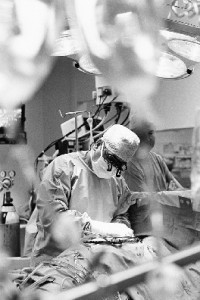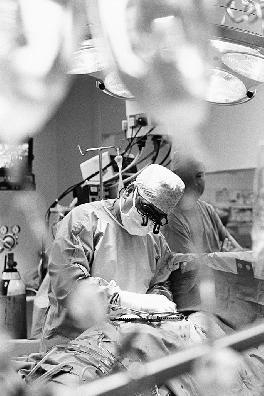 During surgery, the body registers pain, loss, and outrage at being violated. It tries to protect itself from further injury by setting up involuntary muscle contractions and tension in the injured area. In my NMT therapy practice, I have noticed that an area of ticklishness, for instance, in an otherwise non-ticklish person, almost always indicates an unconscious chronic muscle tension. Keeping this internal sentry standing guard can be the cause of a secondary pain, which may even outlast the original cause.
During surgery, the body registers pain, loss, and outrage at being violated. It tries to protect itself from further injury by setting up involuntary muscle contractions and tension in the injured area. In my NMT therapy practice, I have noticed that an area of ticklishness, for instance, in an otherwise non-ticklish person, almost always indicates an unconscious chronic muscle tension. Keeping this internal sentry standing guard can be the cause of a secondary pain, which may even outlast the original cause.
Chronic pain may also indicate the formation of adhesions after surgery. Adhesions are bands of scar tissue that can distort anatomy and glue together organs and tissues that are normally separate. An important clue that adhesions have formed may be the appearance of an external scar. Tissues glued together can cause an uneven look, as the top layer of skin is pulled down toward deeper tissue layers.
Neuromuscular therapy can limit the formation of adhesions and scar tissue in new injuries and can reduce scar tissue, or make it more pliable, at old injury sites.
Things I consider during treatment:
• The structural imbalance to your back that existed long before the pain started. Muscles that have become dysfunctional from working too hard trying to straighten the spine need to be brought back to health. When Trigger Points have developed in those muscles, hyperactive spots must be treated to prevent continuation of the referred pain patterns typical.
• The second thing of interest is the actual spinal nerve involvement. When a nerve gets irritated it sends signals out into the muscles along its pathway. Pressure on the nerve can be eliminated by releasing the tension on the muscles that are moving the vertebrae and holding them together. The disc can resume its natural position within the confines of the bones when the tension squeezing the bones together is released.
• Continued irritation of these muscles can cause local muscle inflammation, formation of other Trigger Points, entrapment of nerves, and resulting muscle dysfunction that can continue long after the source of the excitation in the spine has been removed. These muscles need to be treated locally.
• Scar tissue from the surgery can bind muscles and nerves, restricting normal movement. Stretching and softening the scar tissue reduces its binding effect on the involved tissues
Four goals then might be:
1. Treat Trigger Point sources of pain.
2. Treat the muscles of the spine to release tension on the discs,
3. Heal local muscles inflamed by nerve or trigger point irritation.
4. Soften and stretch the scar tissue.
You can schedule or call for a consultation
References: Travell JG and Simons DD. Myofascial Pain and Dysfunction: The Trigger Point Manual. 2 Vols. Williams and Wilkins. Baltimore. 1983.
Chaitow Leon. Modern Neuromuscular Techniques. Churchill Livingstone Publishers. New Jersey. 1996.
Caillet Rene. Low Back Pain Syndrome. FA Davis Company. Philadelphia. 1988.

